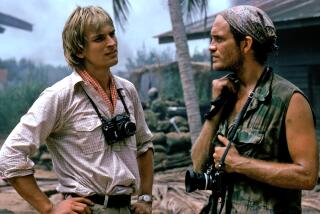An Aye for an Eye in ‘Gray’s Anatomy’
A Spalding Gray film means equal parts humor and dread, digressions and absurdity, meditation and mania, personal confession and Yankee reserve. Add a desk, a mike and a glass of water, and you’ve got the basic formula.
But there’s at least as much different as there is the same about “Gray’s Anatomy,” the third filmed version of a Gray monologue (after the Jonathan Demme-directed “Swimming to Cambodia” and Nick Broomfield’s “Monster in a Box”), and the most cinematic of the group.
This time, Steven Soderbergh takes Gray (who appeared in his little-appreciated gem “King of the Hill”) places he’s never been on-screen. Motion, color and brazen stylizing enhance what is at times a genuinely hysterical work on rationalized terror.
Sprung from Gray’s experience with an eye ailment--”macula pucker” is the diagnosis, a term we come to know and love--Soderbergh chooses to open not with Gray but with a series of first-person accounts of other people’s eye problems. One concerns a fishhook, another, oven cleaner; one man who had steel in his eye tells how he had to finish the brake job on his truck before he could drive himself to the hospital. These are occasionally gruesome stories, but they’re told so casually that they’re funny.
*
And they set us up perfectly for Gray. What he does, through his measured, literate and wryly knowing persona, is convince you he’s a rational man. His response to his disorder, of course, is to flee reason for the arms of New Age humbug, an American Indian sweat lodge ceremony (where he becomes so unnerved he forgets to “give up” his pain) and a Filipino “psychic surgeon” who sounds like a cross between Jackie Chan, Elvis Presley and the Amazing Kreskin.
Although a continuous, seamless piece, “Gray’s Anatomy” has certain individual episodes that shine. The sweat lodge. The Philippines trip. A guilt-ridden bit on Gray’s Christian Science upbringing. And an experience as a day laborer for some Brooklyn Hasidim. Certain he was going blind in one eye, it reassured him that there was work he could do if his other eye went, too.
Never mind that Gray talks for a living, and presumably could, and would, continue to do so whether he could see or not. But imagine the anxiety. Soderbergh would have to film in 3-D.
* Unrated. Times guidelines: adult content.
(BEGIN TEXT OF INFOBOX / INFOGRAPHIC)
‘Gray’s Anatomy’
Spalding Gray: Himself
An Independent Film Channel production in association with BBC Films, released by Northern Arts Entertainment. Director Steven Soderbergh. Producer John Hardy. Executive producers Jonathan Sehring, Caroline Kaplan, Kathleen Russo. Screenplay by Spalding Gray, based on a monologue by Gray and Renee Shafransky. Cinematographer Elliot Davis. Editor Susan Littenberg. Music Cliff Martinez. Production design Adele Plauche. Running time: 1 hour, 20 minutes.
* Exclusively at the Monica 4-Plex, 1332 2nd St., Santa Monica, (310) 394-9741; and Edwards Town Center, 3199 Park Center Drive, Costa Mesa, (714) 751-4184.
More to Read
Only good movies
Get the Indie Focus newsletter, Mark Olsen's weekly guide to the world of cinema.
You may occasionally receive promotional content from the Los Angeles Times.










